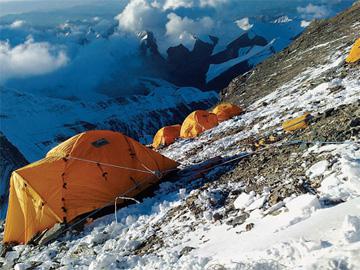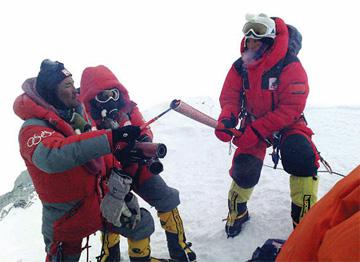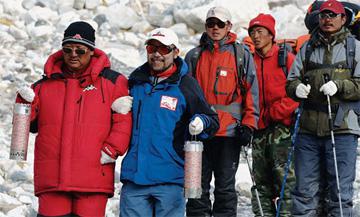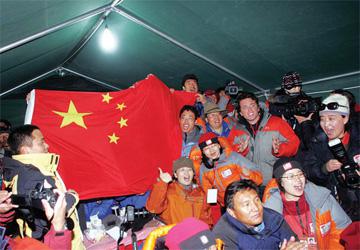The Mountain Summit Auspicious Clouds and Dreams—Recapping the Moment of the Olympic Torch Relay Leg
2008-09-25
The logistics staff working for the preparation of the torch relay on Mt. Qomolangma.
The Beijing leg of the 2008 Olympic torch relay began in spring. Along with the citizens in other cities, we were longing for a distinctive and stunning torch relay in terms of the route and the many colorful ceremonial activities.

The unprecedented plan to extend the torch relay to Mt. Qomolangma will surely attract attention from all over the world. It is the fulfillment of the commitment made by the Chinese Government during the Olympic bid and is the first such an event in the history of the Olympic relay. Ever since the decision was made to include the summit of Mt.Qomolangma as a part of the relay, the world has paid close attention to this event.
On April 16th, 2008, I, together with many other colleagues, set out on the journey to the base camp on Mt. Qomolangma in preparation for the torch relay.
Dreams Hovering around the Mt. Qomolangma
I had been longing to visit Mt. Qomolangma for years so I was overjoyed to be given such an opportunity to go there and, in particular, to get the opportunity to stay and work there for a quite long period at the base camp close to the worlds summit. I thought I was a very lucky person! Then, however, tragedy struck on March 14th and the disturbance created by those insane people during the torch relay around the world created feelings of fear and anger instead of the Olympic ideals of peace and harmony. Under these circumstances, protecting and achieving the ultimate success of the torch relay along the route to Mt. Qomolangma became our greatest challenge. How we were to face vicious and politically disrupting interference by those demonstrators, let alone the dangers from natural forces such as inclement weather and difficult terrain? Therefore we set off for the Mt. Qomolangma Base Camp in advance of the event to prepare for the final success of the relay. Perhaps our greatest regret was the feeling that what should have been a pleasant voyage was, due to the aforementioned events, had turned to a grave responsibility for us.

Setting off not far from Dingri County, we made a turn southward and then drove directly to Mt. Qomolangma. On reaching the peak of Mt.
On May 10th, Jampa Phuntsok (middle), the Chairman of the Government of TAR, lights the sacred flame. On the same day, a grand ceremony for the successful Olympic torch relay was held at the base camp of Mt. Qomolangma.
Gyuwulha, we could easily see all of the summits of a mountain range of which all the mountains were over 8000 meters above sea level. It was very spectacular. The mountains were due south, their summits piercing the sky. We stopped the car and took time to view the mountains: Mt. Qomolangma, Mt. Changtse, Mt. Lhotse, Mt. Jowowuyag, and Mt. Makalho.

Before this trip the names of those mountains seemed like an alien language to me. I was unacquainted with the real meaning of the names in Tibetan language. At the north of Mt. Qomolangma, Mt. Changtse is so named because the word “Chang” in Tibetan refers to “the north” and “Tse” is “the peak”. Since Mt. Lhotse actually lies to the south of the Qomolangma, the word “Lhotse” in Tibetan means the peak of the south. Respectively, the word “Jowo” in Tibetan is “the Buddha” and the word “Wuyag” is equivalent to the Tibetan word for “the head”. In fact, when you are seeing it from a distance, the peak of Mt. Jowowugay looks just like the head of Buddha. While I was worshiping these grand mountains, we were gradually nearing the Rongpa Base Camp -- the absolute bottom of Mt. Qomolangma.
While staying at the camp I was often awoken by horrendous winds in the early morning, about 6 oclock. The wind blew fiercely over one hill after another like so many unleashed wild monsters dashing from the south to the north and then onto Mt. Qomolangma... or maybe from Mt. Qomolangma and then crossing to far distant mountain ranges to the south. Notwithstanding, neither the giant mountains nor the small hills would flinch, but rather solemnly held their ground and calmly faced all comers.

Those hills are the last remaining trace of the retreat of the glaciers. We could easily observe the lower terraces between the mountain peaks but these terraces are a different shape from the common ravines. The former tend to be U-shaped, caused by the retreat of glaciers, and the latter are shaped as a V due to erosion by water from the top of the mountains. Of course, the shape of these terraces was formed over an enormous number of years. Nevertheless, I maintain that the V-shaped terrace is the effect of fresh water over a comparatively short time. The U-shaped ravine, on the other hand, usually takes ages to be formed--maybe several million years.
By noon, I stood in the U-shaped ravine and looked up. Mt. Qomolangma was sky high and
On May 8th, the Beijing Olympic torch relay team successfully reached the summit of Mt. Qomolangma. Lozang Dradul lit the first torch that had been named “Auspicious Clouds” and was held by the female Tibetan mountaineer Jiji.
capped by “auspicious clouds”. It looked like a giant glacier itself.
Auspicious Clouds on the Mountain Summit
Day after day, while looking at Mt. Qomolangma, my imagination ran wild. Strictly speaking, in
the first ten days after arriving at the camp, life was very peaceful. Everyday, I worked with the others to erect movable shutters, installed and adjusted equipment and made basic logistic preparations. Most of our time was spent waiting for the coming of the mountaineers and the media. We kept our fingers crossed for wonderful weather on the day when the torch relay came to the mountain summit.

In our spare time, I liked to take a walk around the camp fringe with Liu Feng, a staff member for the Beijing Olympic Committee. Sometimes we took the opportunity to photograph the fascinating scenery. On talking with him, I became acquainted with the origins of the plans for taking the torch relay to Mt. Qomolangma. At first the Chinese Mountaineering Association wanted to ignite the torch flame by using the occasion of the 21st Universiade in Beijing which was an eleven-day multi-sport event beginning on August 22, 2001.
However, when the Chinese Mountaineering Association (CMA) presented this proposal to the World Committee of the 21st Universiade, the torch flame scheme had already been confirmed. Later, when Beijing made its second bid for the Olympics, CMA brought the proposal to the Beijing 2008 Olympic Bid Committee. The Olympic rule by which the torch flame must be originally ignited in Greece blocked the general proposal, but the committee fortunately retained the idea of the torch reaching Mt. Qomolangma.
On April 29th, the media began to camp at the Rongpa Media Center, adjacent to the Rongpa Monastery but still eight kilometers away from the base camp. Several organizing teams were based at the media center, including the mountaineering training team, the torch research team, and the team from China Center Television (CCTV). Team members maintained a busy but peaceful working and living environment. Everything seemed to be in perfect order, since they all believed their efforts would contribute to and guarantee the successful torch relay to Mt. Qomolangma. Generally speaking, the aim was threefold: reach the peak, ignite the flame and then highlight the event in the spirit of the Olympics through a live broadcast to the world. CCTV sent a big delegation to the base camp to work with China National Radio, China Radio International, Xinhua News Agency and other media to

accomplish media coverage of the event. Every part of the preparation, such as installing and adjusting the broadcasting equipment, was a labor of love for those involved.
After May 5th, we felt time was running out and the historic moment was near. After two days of snow, the weather turned fine. Information from the organizers was gradually disseminated at an increasing rate: the confirmation and announcement of the names of mountaineering coaches, the 31 mountaineers, the route to access the summit of Mt. Qomolangma, and the names of the 19 leaders from the mountaineers.
At 11 pm on May 7th, the director of the Media Center rushed back to the Center from the base camp, in the dark, and called a press conference. He formally announced the next days challenge to Mt. Qomolangma by the Chinese mountaineers. CCTV was appointed to broadcast the whole proceedings live and exclusively.
From 1:30 a.m. to 3:30 a.m. on the following day, the 19-man mountaineering team, together with cameramen, was divided into several groups to set out from the camp located on the north flank of Mt. Qomolangma (about 8300 meters above sea level). They trekked upward for over five hours in the dark and step-by-step they reached the most dangerous precipices known as “the second terrace” or the “giant snow slope”. About 7:10 in the morning, they reached an area close to the summit, 8800 meters above sea level. Without stopping to catch their breath, they carefully walked along a path that was only tens of centimeters wide-the right-hand side being a thousand-meter drop. Despite the danger, the experienced mountaineers forged bravely upward.
Fortunately, the whole mountaineering procedure went smoothly and successfully under the guidance of the mountaineers. In particular, when they initiated their final push to the summit, their superhuman physical strength and courage were amazing.
At 5:10 a.m., some mountaineers had already reached the second terrace that was 8680 meters above sea level. By 6 a.m., the advanced group had crossed the second terrace to challenge the 8700-meter level.
At 8:30 a. m., several mountaineers had successfully arrived at the summit level and started to prepare for the torch relay to the top of Qomolangma, although Li Zhixin, the Chief Commander of the event, was constantly reminding them by radio from base camp: “Slowly! Slowly! Be careful to conserve your physical strength all the time”.
At 9 oclock in the morning, the mountaineers reached their destination and were ready for the torch relay. The ceremonial moment of igniting torch flame was at hand.
About 9:11a.m, at a spot 30 meters from the peak, Lozang Dradul ignited the first torch that had been named “Auspicious Clouds” and was held by the female Tibetan mountaineer Jiji. Then, the torch was relayed to Wang
Yongfeng, Nyima Tsering, Huang Chungui, and finally to another female Tibetan mountaineer, Tsering Wangmo, who gave a final display of the now well-alight torch on the summit of Mt. Qomolangma.
The successful torch relay ceremony on the summit of Mt. Qomolangma was closed by the unfolding of the five-star flag of China, the flag of the Olympics, and also the Beijing 2008 Olympic flag. It was the historic moment at which China had fulfilled its solemn oath
to the International Olympic Committee and also to the world, to take the torch relay to the summit of Mt. Qomolangma.
At this moment, I remembered the 112th Session of the International Olympics Committee, held on July 13th, 2001 at Masco. Yang Lan, the plenipotentiary in Chinas bid for the 29th Olympics, said that having been inspired by the Silk Road, our torch relay would usher in a new era, from Mt. Olympus, via the origins of ancient human civilization- Greece, Rome, Egypt, Byzantium, Mesopotamia, Persia, Arabia, India, and then to China. Adopting the slogan of “One World, One Dream”, we would carry the ever-lasting Olympic flame over the Himalayas to the summit of the world, Mt. Qomolangma, and set a new precedent for the Olympic spirit. Yang Lans words, by which the committee, by and large, were deeply touched, truly expressed the great ambition of China to enhance the Olympic ethos. The final decision of International Olympic Committee to appoint Beijing as the host of the 2008 Olympics, therefore, provided a unique opportunity to draw together mountaineering as a sport and the sports of the Olympics.
However, some people questioned the capacity and competence of China. They asked if it was possible for China to fulfill its ambitions. When the “Auspicious clouds” reached to the top, the glory would be possessed by not only those mountaineers, but also, the most importantly, the Peoples Republic of China.
The journey of the Olympic torch to Mt. Qomolangma was the fulfillment of the solemn promise from China to the world during Chinas bid for the 2008 Olympics, and also a highlight of the preparations for the Beijing Olympics. Intense efforts over the three years of preparation by China meant the success of the torchs journey to Mt. Qomolangma was finally complete in this historic addition to the ethos of the Beijing Olympics.
杂志排行
Tibet的其它文章
- The Fraternal Bond between Ethnic Tibetans and the Victims of the Wenchuan Earthquake
- The Train Carries Love from the Sunlit City to the Victims
- Paljor Lhunpo Today
- Tsakhalho:Salt Production and the Preservation of a Church
- Trees in Lhasa
- Searching for a younger Generation of Tibetan Minstrels toSing the King Gesar
